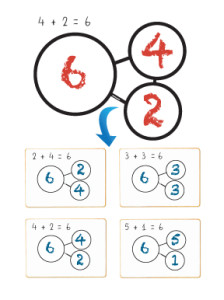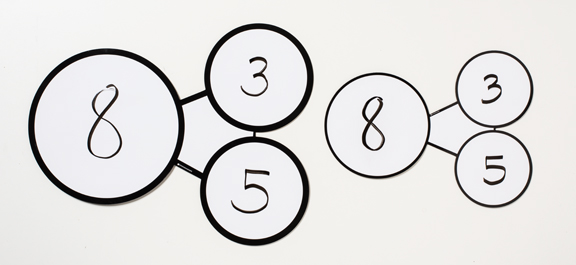Help Children “Win” at Every Stage of Math Instruction with Versatile Number Bonds Magnets
Two . . . four . . . six . . .eight . . . how do we learn to calculate? Manipulate? Articulate?
But preparing students to be “college and career ready” involves more than calculation; students must become problem solvers who know how to choose the right math strategies to manipulate facts and be able to articulate the strategies they use.
So what’s the math game plan? Well, one key strategy for elementary students is to learn how to use a number bond. Number bonds involve separating numbers into fact families and putting them back together again. Hence, learning number bonds helps students internalize those important relationships between numbers.
A number bond tool can be used at each of the three stages through which children progress as they learn (and eventually master) math concepts: concrete, pictorial, and abstract. In the concrete stage, children manipulate physical objects to show a number/quantity. The pictorial or representational stage involves the use of pictures (or sometimes manipulatives) to represent a number. Finally in the abstract stage, children are ready to use numerals (abstract symbols) to indicate quantities.
The key is to choose a number bond teaching tool that was designed with versatility in mind so it’s able to “grow” with each learner and facilitate each of these stages. Hey let’s face it, as a teacher, I’m always looking for this kind of convenience and for ways to get more bang for my buck!
The Number Bond Magnet Set is a great example of a versatile number bond tool! Here’s why:
- It includes two sizes of magnetic, dry-erase number bond magnets: a large number bond magnet to be used for teacher demonstration and four smaller number bond magnets (that fit on student-size, magnetic lap boards) to be used for individual student practice.
- BOTH sides of the magnets are magnetic. Why is that important?
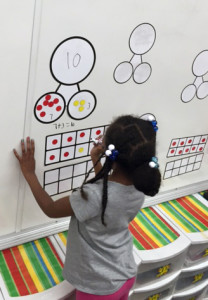 Because not only will the bonds stick to the whiteboard, but Magnetic Two-Color Counters (sold separately) will stick to their top surfaces! That means students can use them in the concrete stage to count out, move, and explore the different quantities that make up a given number…in a very hands-on way.
Because not only will the bonds stick to the whiteboard, but Magnetic Two-Color Counters (sold separately) will stick to their top surfaces! That means students can use them in the concrete stage to count out, move, and explore the different quantities that make up a given number…in a very hands-on way. - The dry-erase feature of the magnets
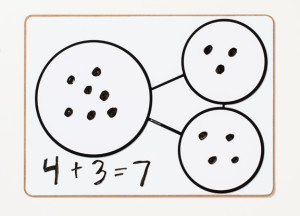 in this Number Bond Magnet Set is ideal for facilitating the transition to the pictorial stage. Students can draw dots or other small pictures within each circle of the number bond. They can even use different colored markers to help visualize the concepts better. Once students start to grasp these concepts, you can begin to introduce numerals alongside the pictures (or counters). Then eventually you can transition students to using only numerals. Because the surfaces of the magnets are dry-erase, you can just write in the numerals whenever the children are ready for them.
in this Number Bond Magnet Set is ideal for facilitating the transition to the pictorial stage. Students can draw dots or other small pictures within each circle of the number bond. They can even use different colored markers to help visualize the concepts better. Once students start to grasp these concepts, you can begin to introduce numerals alongside the pictures (or counters). Then eventually you can transition students to using only numerals. Because the surfaces of the magnets are dry-erase, you can just write in the numerals whenever the children are ready for them.
- Another way to help students transition from the pictorial stage to the abstract is
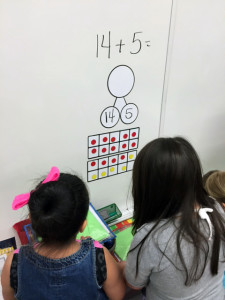 to use a number bond magnet above or next to a Ten Frame Magnet Set. Students can use the ten frame and counters for the pictorial representation and then write the numerals in the number bond.
to use a number bond magnet above or next to a Ten Frame Magnet Set. Students can use the ten frame and counters for the pictorial representation and then write the numerals in the number bond. - The space within the circles of the number bonds are NOT cut out–the magnets are SOLID pieces. They’re more durable than just flimsy black magnetic frames. I feel confident letting my young students use these magnets in centers, so they get a more hands-on approach than just number bond worksheets!
- Although the smaller student-size magnets fit on magnetic lap boards, I found
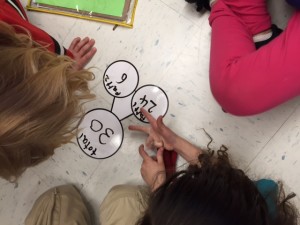 the number bond magnets durable enough to use without a board surface! As you can see in my classroom photos, I simply handed the magnets to the students and let them use them right on top of their desks…and even on the floor! (I love letting children work on the floor. They think it’s more fun–kind of like breaking the rules, I guess. Plus, getting them up and moving helps hold their attention!)
the number bond magnets durable enough to use without a board surface! As you can see in my classroom photos, I simply handed the magnets to the students and let them use them right on top of their desks…and even on the floor! (I love letting children work on the floor. They think it’s more fun–kind of like breaking the rules, I guess. Plus, getting them up and moving helps hold their attention!) - The versatility of this kind of a number bond set really lends itself to differentiating instruction when teaching word problems too. Here’s what I mean. Provide students with a word problem such as:
Taylor picked four apples; then, she picked two more.
How many apples did Taylor pick?
Demonstrate how to write the numerals in the smaller circles. Students who need more assistance can use manipulatives to count out the quantities. Children who are more comfortable drawing dots can illustrate the problem within the circles. More advanced students may complete the problem using only numerals and can challenge themselves to come up with other numbers that they can compose to get the same answer…or they can even use the numbers they started with to explore more difficult operations, such as subtraction, multiplication, or division!
The Number Bonds Magnet Set provides versatile, durable magnetic tools that you and your students will use over and over again to succeed in math. Each child, no matter their stage of math concept mastery, can receive the support he or she needs. It’s a win-win! Make these number bond magnets a part of your game plan for the school year!
Tags: Dowling Magnets , magnetic counters , magnetic lap boards , magnetic manipulatives , number bond magnet set , number bonds , ten frames
Share This:

